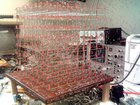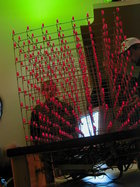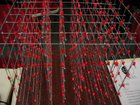Borg3d/en
Borg 3d[Bearbeiten | Quelltext bearbeiten]
Facts[Bearbeiten | Quelltext bearbeiten]
- 8x8x8 LEDs
- every LED can be controlled individually
- One Laborboard with ATMega32 as controller
- build by Martin Ongsiek
Photos and videos[Bearbeiten | Quelltext bearbeiten]
Hardware[Bearbeiten | Quelltext bearbeiten]
The Borg is controlled through an Atmel ATMega32. It has interfaces for RS232, CAN bus and for two joysticks (the old digital ones from the C64).
The 512 LEDs are controlled time-multiplexed (matrix wiring). This is realized through 8 planes of 64 LEDs, which can be controlled one per timeintervall. The planes are switched about 1000 times per second, so it seems like all 512 are controlled individually at the same time with 4 brightness levels available.
At the moment there is no official schematic, pcb or kit available, but you can have a look at the schematics made for our prototypes. Find them in our subversion repository here (schematics and layout)
Contact us if you want to build such a Borg, so we can hint you at a thing or two. As the first prototypes were not perfect, there are several optimizations now, which are not documented.
The page Build a borg 3d describes how the Borg is build.
Software[Bearbeiten | Quelltext bearbeiten]
At the time being all animations on the Borg 3d are rendered live. There are no videos and a PC is not needed. You only have to plug in the power connector to get it up and running. A support for videos and especially for music visualization is planed but not implemented. There are also plans to enable the creation of movies with a graphical tool. The complete software is written in C for the avr-gcc and can be found in our Subversion at.] directory.
Simulator[Bearbeiten | Quelltext bearbeiten]
To develop new animation on a PC, we also built a simulator, which is programmed with the good old opengl-framework GLUT. It is divided into threads:
- Thread 1 displays the frame-buffer, that is like the original, in the opengl.
- Thread 2 is like the original with the difference , that the wait routine is replaces and other files are included.
This does work so well that we normally cut and paste the simulator animation in the source of the original and have it running. The Simulator can be found in our Subversion at the microcontroller/borg/borg-3d-apiSimulator directory.
History[Bearbeiten | Quelltext bearbeiten]
Martin had found this page of james clar long before he had ever been to the Labor and met Peter. He was exalted and wanted to build such a cube on his own. He also wanted to have a real 3d display and to make something useful with modern micro controllers. So he went to the Labor's first microcontroller workshop and soldered his own Laborboard.
At first he build a 3x3x3 prototype to get a clue how to do the wiring of the LEDs and the cube.
After the 3x3x3 borg worked fine he started building the first 8x8x8 Borg. The amount of work for the soldering and the driver board and so on was much higher than expected.
Exhibitions[Bearbeiten | Quelltext bearbeiten]
- Linux Tage Essen 2005 (3. - 4.12.2005) - http://essen.linux-tage.linec.de/
- 22. Chaos Communication Congress (26. - 30.12.2005) - http://events.ccc.de/congress/2005/?language=de
- pong.mythos (10.02.2006 - 01.05.2006) - http://www.pong-mythos.net/
- Games Convention / pong.mythos (24.08.2006 - 27.08.2006)
- 23. Chaos Communication Congress (26. - 30.12.2006) - http://events.ccc.de/congress/2006/
- Chaos Communication Camp (08. - 12.08.2007) - http://events.ccc.de/camp/2007/
- Kornhausforum in Bern / pong.mythos (17.08.2007 – 16.09.2007) - http://www.pong-mythos.net/
- 24. Chaos Communication Congress (26. - 30.12.2007) - http://events.ccc.de/congress/2007/


